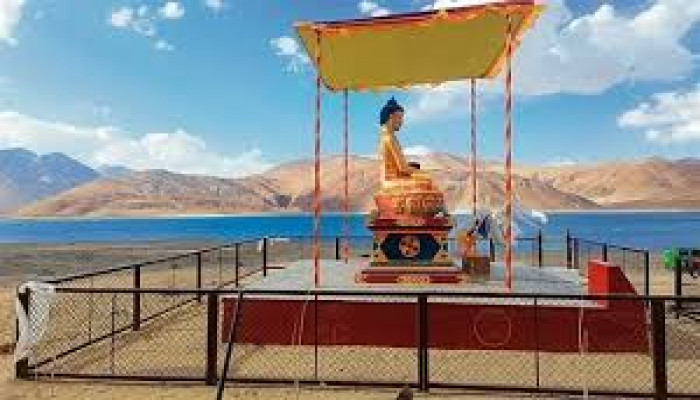Buddha statues installed at 1962 India-China battle sites along LAC
- In Reports
- 08:39 PM, Jul 09, 2024
- Myind Staff
Amid ongoing efforts by India and China to improve relations along their shared border, the Indian Army has begun installing Buddha statues in eastern Ladakh. This move comes as tensions persist on the Line of Actual Control (LAC), with both countries recognising that prolonged conflict is not in their best interests.
Near the LAC in eastern Ladakh, where China has strengthened its military presence, the Indian Army has placed Buddha statues along Pangong-Tso Lake. The army stated that this initiative aims to promote peace in the region, reflecting India’s commitment to 'Vasudhaiva Kutumbakam'. Meanwhile, recent satellite images have shown developments in China’s military infrastructure near the lake.
The 14th Corps (Fire and Fury) stationed in Leh showcased images of the Buddha statues on social media, emphasising their installation in Lukung and Chushul, depicting the 'BhumiSparsha Mudra'. These installations are part of the Vibrant Village initiative, which aims to improve local infrastructure and foster community development in the border villages of eastern Ladakh. As part of this initiative, the army, in collaboration with local authorities actively engaged in the development of villages located near the Line of Actual Control (LAC) in eastern Ladakh.
The army's X account shared a video showcasing Buddha statues and ongoing development efforts, emphasising the message of "The world is one family" to promote unity, preserve spiritual values, and maintain eternal peace in the forward areas of eastern Ladakh.
In response to ongoing tensions following the Galwan Valley clash, both India and China have deployed approximately 50,000 troops each, along with extensive military hardware. Despite some localised resolutions, disputes persist in areas like Depsang Plains and Demchok. Looking ahead, the army plans to install two more statues of Lord Buddha. One of these will be placed in Demchok, while the location for the other statue is yet to be finalised.
Following a meeting between External Affairs Minister S Jaishankar and his Chinese counterpart Wang Yi in Astana, Kazakhstan on July 4th, both ministers emphasised the need to resolve longstanding disputes, including those along the Line of Actual Control (LAC). They acknowledged that prolonging these disputes is not in the best interests of either country, underscoring the importance of intensified efforts to find a resolution.
However, shortly after these diplomatic discussions, satellite images revealed increased Chinese military activities in the Sirijap area near Pangong Tso. This development contrasts with India's strategy of maintaining a mirrored deployment and enhancing infrastructure along the LAC, aimed at preventing further escalation following the Galwan incident.
Near the Line of Actual Control (LAC), China has constructed two bridges to connect the northern and southern ends of Pangong Lake, facilitating quicker troop movements. Pangong Tso, located at an altitude of approximately 14,000 feet, stretches about 140 km in length. It is considered the world's longest lake at such a high altitude, with roughly one-third of its area lying within India's territory and the remaining two-thirds under Chinese control.
During the 1962 war, China gained control over the Sirijap area from India, and it has remained under Chinese administration since then. At a recent event in New Delhi, Chinese Ambassador to India Xu Feihong expressed optimism about bilateral relations, emphasising the importance of adopting broader perspectives and collaborative leadership.
Ambassador Xu remarked, "The two countries are very close neighbors. If we look from our own perspectives, we will not be able to see the full picture of the Himalayas. Only if we rise higher, we will be able to see farther." This statement underscores the need for both countries to elevate their vision to gain a comprehensive understanding of the complex Himalayan region. He voiced confidence in the future stability and mutual benefits of China-India relations under the leadership of Prime Minister Narendra Modi and President Xi Jinping.
Amid ongoing complexities along the Line of Actual Control (LAC), initiatives such as the installation of Buddha statues by India aim to promote peace and stability. These efforts reflect India's strategic approach amidst continuing challenges along the border.
Image Source: Reddit







Comments